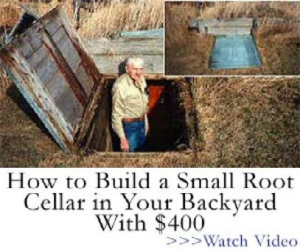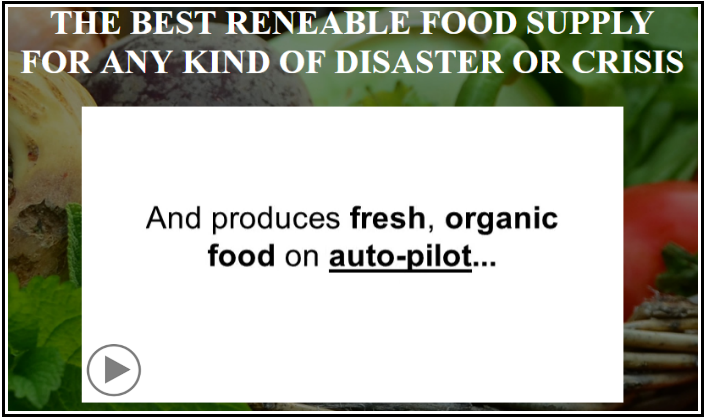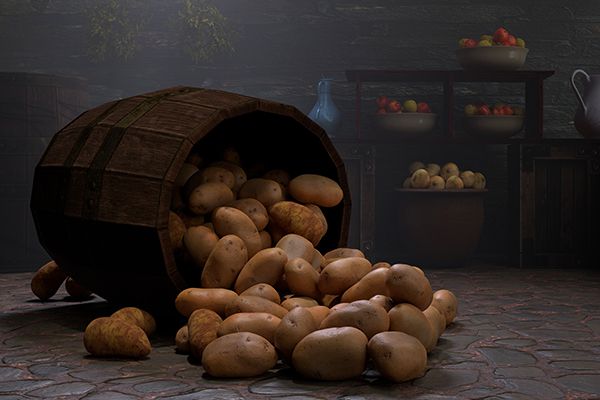If you have a basement or even room under your house, you can create a root cellar to store food! The trick is going to be making it work with what you have, and all of us are in different situations when it comes to our home setup.
Technically, a root cellar is any storage location that uses the natural cooling, insulating, and humidifying properties of the earth to store food. Whether you stock a root cellar with your own homegrown produce or the bounty from local farmers’ market, it’s a time-tested storage method and could come in handy if we lose power for a long period of time.
Before we had refrigeration (a refrigerator in our homes), an underground root cellar was an essential and effective way to store carrots, turnips, beets, parsnips, potatoes, onions, and other root vegetables that were grown in our gardens. Today, root cellars have made a comeback to keep food from freezing during the winter and keep food cool during the summer to prevent spoilage.

A root cellar is also the perfect place to store jars of canned or pickled vegetables, canned meats, and the bulbs or rhizomes of perennial flowers as well. A secondary use for the root cellar is as a place to store wine, beer, or other homemade alcoholic beverages. You could also store any alcohol you intend to use for bartering or first aid during a SHTF situation in your root cellar.
How To Start Your Root Cellar
To work properly, a root cellar must be able to hold a temperature of 32º to 40ºF (0° to 4.5°C) and a humidity level of 85 to 95 percent. This means that root cellars may not work if you live in a warm, southern climate. We live in agricultural zone 4b (gets down to -20 degrees F) and our root cellar perfectly stores our garden potatoes, carrots, onions, parsnips, and rutabagas. We have never measured the humidity or the temperature in our root cellar, however, we are able to store root vegetables and our canned foods down there all winter long.
If you already have a dark underground area, you could be set. If not, keep in mind that root cellars should not be built in places with a high water table or a septic system nearby. Also, you’ll want a close and easily accessible location. Some people have built them under a garden shed so they don’t have to remove snow to access it during the winter.
The best method is to use the foundation walls on the northeast corner as two sides of your root cellar. According to Almanac, you will need to build the other two walls in the basement with stud and board. Insulate the interior walls, ceiling, and door (and any pipes or ducts) to keep the heat out. Ensure there is a ventilation system that allows cool, fresh air from the outside to be brought into the root cellar and stale air to be exhausted out. This helps to prevent mold and mildew.
If you already have a crawlspace, use it! The concert foundation provides the “walls” and while the ceiling (which is the floor of our home) is low, we don’t live in there, so it doesn’t matter much. You can use what you have, or, if you don’t have ideal space, you can dig horizontally into the side of a hill on your property.
Dig A Root Cellar
This option requires good drainage; sandier soil works better. An elevated slope helps because the water will run away from your pit as it moves downward. If your winter temperatures drop below 25°F (-4°C), dig your pit deep enough so that all the crops are under the soil’s surface. Sometimes, this can be too much, especially during winter.
Garbage Can Root Cellar
Did you know you can make a root cellar out of a metal garbage can? You can pick these up at local hardware stores, or big box stores like Lowe’s or Home Depot. A metal garbage can with a lid is ideal, as it will help eliminate water and keep your vegetables from getting wet. Dig a hole slightly larger than the diameter of the garbage can and deep enough so that the can’s lid will sit 4 inches above the soil level. Backfill dirt around the garbage can. Then add straw inside the can with the crops, and cover the lid with straw or mulch and a sheet of plastic to keep everything dry. Root vegetables will store well in this environment, even in the coldest weather! It isn’t the biggest space, but it could get you by and you could always use more than one garbage can if you need to!
Keep in mind that some vegetables, such as onions, should be “cured” before going into your root cellar. We made this mistake once and lost every single onion from our harvest one year. But, lesson learned, just cure them in warmer temperatures before storing.

Root cellars are easy to create and easy to use. if you don’t know if the environment you have chosen will work, consider getting a cheap thermometer and humidity gauge and test it out! We store all our preparedness foods in our root cellar and have it packed pretty full, but you don’t necessarily need to store canned goods or toilet paper in there. We just simply have the space to do so. If you don’t, at least consider using a root cellar for your vegetable harvest!
source : Sara Tipton



